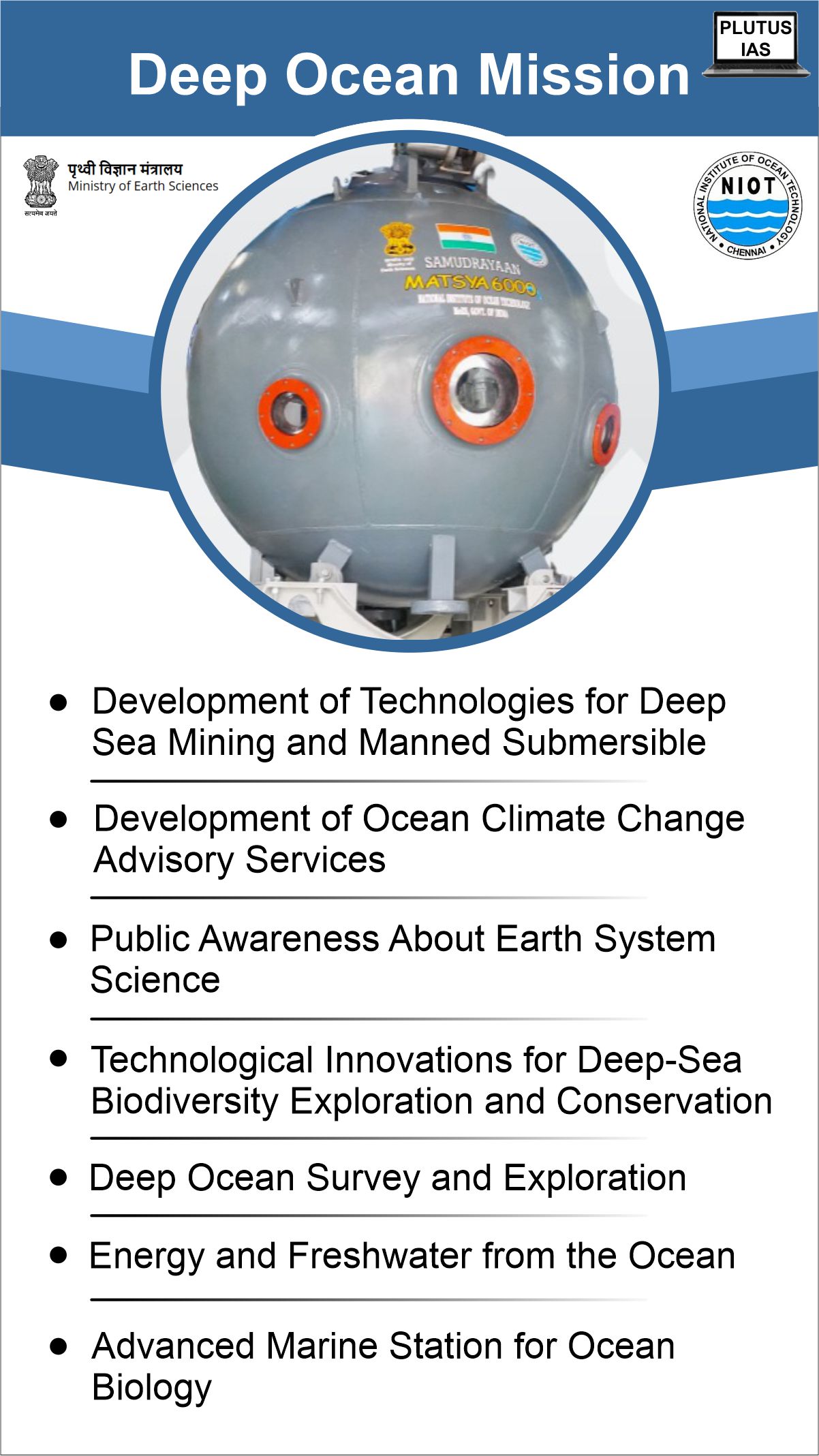20 Sep Matsya 6000
This article covers “Daily Current Affairs” and the topic details “Matsya 6000”. This topic has relevance in the “Science and Technology” section of the UPSC CSE exam.
For Prelims:
What is Samudrayaan Mission?
What is Matsya 6000?
For Mains:
GS3: Science and Technology
Why in the news?
India is preparing for an ocean expedition after the successful Chandrayan 3 and Aditya L1 missions.
India’s First Manned Deep Ocean Mission: Samudrayaan
- India’s first manned Deep Ocean Mission, “Samudrayaan”, aims to study deep-sea resources and biodiversity without disrupting the ocean ecosystem.
- Samudrayaan plans to send three humans to depths of six kilometres under the sea using Matsya 6000- the first Manned Submersible in India.
- The venture supports the ‘blue economy’ vision, which focuses on the sustainable use of ocean resources for the country’s economic growth, improved livelihoods, job opportunities, and preservation of ocean ecosystem health.
- The Ministry of Earth Sciences (MoES) is the nodal ministry implementing this ambitious, multi-institutional mission.
Matsya 6000: India’s First Manned Submersible
- Developed by Chennai’s National Institute of Ocean Technology (NIOT), Matsya 6000 is a three-person submersible capable of descending 6000 meters underwater.
- According to news reports, the Matsya 6000 will undergo trials in the Bay of Bengal in early 2024.
- The submersible is part of India’s Rs 4,077-crore Deep Ocean Mission, planned to launch by 2026.
- It would make India one of just six countries (the United States, Russia, Japan, France, and China) to have piloted a crewed undersea expedition deeper than 5,000 meters.
Structure and Design of Matsya 6000
- The Matsya 6000 is a 2.1m-diameter sphere made of an 80mm-thick titanium alloy, built to withstand pressure 600 times greater than that at sea level.
- It can operate for 12 to 16 hours straight and has an oxygen supply that extends up to 96 hours.
- For safety purposes, redundancy is applied to all components, excluding the sphere.
- The submersible design was reviewed after the previous Titan submersible disaster, leading to a change from using Carbon fibre to insisting on titanium enclosures. Given its strength and fracture-resistant properties, titanium is considered the best option for deep-sea exploration.
- The Matsya 6000 also features a USBL (ultra-short baseline) acoustic positioning system for optimal safety. This system facilitates communication with the mothership carrying the transponder above the water surface.

Significance of Deep Ocean Mission
Adding Value to Biodiversity and Tourism
-
- The Matsya 6000 is expected to explore chemosynthetic biodiversity in hydrothermal vents and low-temperature methane seeps in the ocean.
- Additionally, it aims to promote tourism and ocean literacy, thereby adding value to India’s blue economy.
- Exploration of Ocean Resources
- The Samudrayaan project endeavours to discover precious metals such as cobalt, copper, and manganese. In addition, it aims to catalogue the ocean’s biodiversity.
- India’s Vision for Ocean Exploration and Conservation
- India strives to play a critical and leadership role in the exploration of the ocean and the sustainable development of resources to maintain a balanced ecosystem.
- The country’s approach to ocean exploration focuses on research, preparing for deep dives, and encompassing land and ocean ecosystems’ connectivity.
Way Forward
- The government is actively promoting the blue economy, angling to increase its contribution to the national GDP, currently less than 10%.
- Developing coastal economies and leveraging potential ocean resources, India envisions transforming oceans from a vast, potent canvas to a resourceful powerhouse.
Sources: Matsya 6000: All you need to know about India’s first manned submersible
Download plutus ias current affairs eng med 20th Sep 2023
Q1. With reference to Matsya 6000, consider the following statements:
- Matsya 6000 is a three-person submersible developed by Chennai’s National Institute of Ocean Technology (NIOT).
- The submersible will undergo trials in the Arabian Sea in early 2024.
- India will be one of the four countries to have piloted a crewed undersea expedition deeper than 5,000 meters.
Which of the statements given above is/are NOT correct?
(a) 1 and 2 only
(b) 2 and 3 only
(c) 3 only
(d) None
Q2. Consider the following statements with reference to Matsya 6000:
- The Ministry of Science and Technology is the nodal ministry implementing this ambitious, multi-institutional mission.
- Matsya 6000 can operate for 24 to 36 hours straight.
- It is a three-person submersible capable of descending 6000 meters underwater.
- It can withstand pressure 6000 times greater than that at sea level.
How many of the statements are correct?
(a) Only one
(b) Only two
(c) Only three
(d) All Four
Q3. Analyse the significance of the Deep Ocean Mission- Samudrayaan in the context of India’s Blue Economy and the exploration of deep-sea resources. Discuss the potential economic and scientific impact of this mission.




No Comments